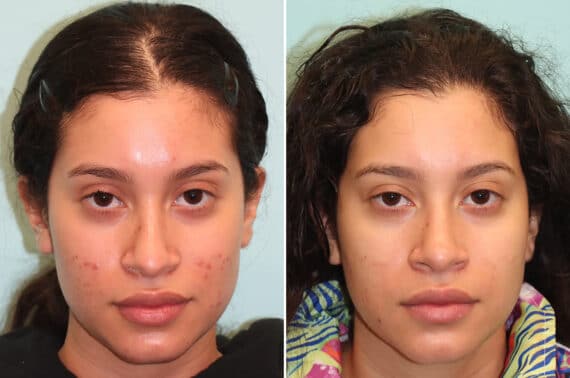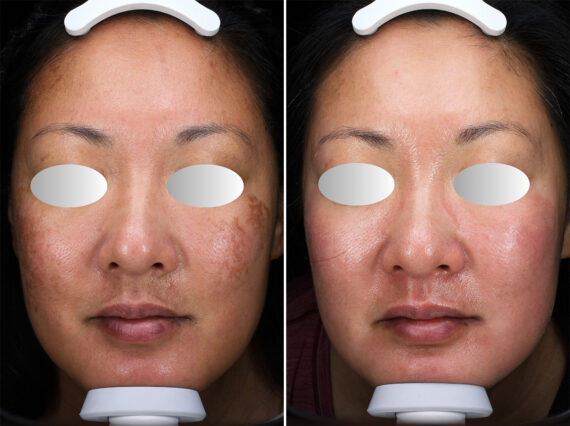Hyperpigmentation is usually a major problem for all people, irrespective of their skin type, but it can be more complicated when it comes to skin of ethnic groups. At The Naderi Center for Plastic Surgery and Dermatology, our dermatologists are fully aware of how sun exposure, acne, hormones, and genetics can lead to the development of uneven pigmentation. We use state-of-the-art technology combined with highly individualized care to make it possible for the patient to prevent, control and heal hyperpigmentation of the skin with clear and radiant skin as the result.

Highlights for Treating Pigmentation in Skin of Color
- Hyperpigmentation is a condition of the skin that leads to the production of an excess amount of melanin that, in turn, causes the appearance of dark spots or an uneven skin tone.
- Skin of ethnic origin is more susceptible to hyperpigmentation because it contains higher levels of melanin.
- The foundation for the prevention of hyperpigmentation is consistent usage of sunscreen and a personalized skincare routine.
- All skin tones can receive the laser treatment, chemical peels, and medical-grade skincare which is safe and effective at The Naderi Center.
- With the right support and consistent treatment, the results will not only be beautiful but will also last for a long time.
What Is Hyperpigmentation?
Hyperpigmentation is one of the most common skin concerns we see at The Naderi Center for Plastic Surgery and Dermatology in Reston Virginia and Chevy Chase, Maryland offices. At its core, hyperpigmentation is an overproduction of melanin—the natural pigment that gives skin, hair, and eyes their color. When melanin is distributed unevenly, dark patches, spots, or discoloration form, leading to a complexion that looks uneven and aged.
Why It Affects Ethnic Skin Differently
The overproduction of melanin can be triggered by many factors. In ethnic skin, which naturally contains more melanin, this process is amplified. People of African, Middle Eastern, South Asian, and Latino descent often experience hyperpigmentation more easily, making prevention and treatment both more complex and more necessary.
Dr. Shervin Naderi explains, “Melanin is both your friend and your challenge. It protects against UV damage, but it also makes skin more reactive. That means hyperpigmentation is more likely to happen in patients with darker skin tones.”
Causes of Hyperpigmentation
Causes of hyperpigmentation include:
- Chronic sun exposure
- Trauma to the skin (such as from surgery or cosmetic procedures)
- Acne scarring
- Natural aging process.
Hormonal changes and genetics can further increase susceptibility.
Prevention and Skincare Regimen
Prevention is the first method of protection. A medical-grade skincare routine is necessary for patients who want to prevent hyperpigmentation from returning. At The Naderi Center, we design routines that lower melanin production and work to keep the skin tone balanced over time.
Key Ingredients in Prevention
- Hydroquinone: It remains one of the most powerful ingredients for blocking melanin production.
- Gentler alternatives: Options like Alastin’s Illuminate provide gradual improvement with fewer side effects.
A combination of prescription-strength and maintenance products is often the most effective approach.

Daily Habits That Protect the Skin
When discussing hyperpigmentation management, sun avoidance is non-negotiable. The daily application of sunscreen, particularly during the times of the day when the UV index is highest, is considered to be one of the easiest and most effective ways to stop pigmentation from getting worse.
Equally, it is necessary to prevent any kind of trauma to the skin. Extracting acne lesions, scratching of scars, or excessive rubbing of the skin can all result in post-inflammatory hyperpigmentation, which may last for months or even years before it disappears.
Why Experience Matters: The Naderi Center’s Approach
At The Naderi Center, we treat patients of every background. Our patients have many skin tones, so we have observed every form of hyperpigmentation. Our board-certified facial plastic surgeons and dermatologists focus on safe, effective treatments for all skin types.
Treatment Options for Hyperpigmentation
Patients who decide to proceed with treatment receive one of multiple therapies that we select according to skin type, sensitivity and excess pigmentation.
Advanced Laser and Light Therapies
One of our most advanced tools is the erbium cold fiber laser, also known as the UltraClear laser. This device is safe across skin tones, delivering dramatic results with minimal downtime.
Intense pulsed light (IPL) therapy can also be beneficial for select patients. While traditionally IPL was not recommended for darker skin tones, advances in technology and careful patient selection allow us to use IPL safely in some cases.
Chemical Peels That Respect Ethnic Skin
Chemical peels are another cornerstone of hyperpigmentation treatment. When performed by experts who understand ethnic skin, chemical peels can gradually lift pigmentation and rejuvenate skin without increasing the risk of scarring or post-peel darkening.
Medical-Grade Skincare for Ongoing Results
Medical-grade skincare remains the foundation of professional treatment. Products with active ingredients like tretinoin, hydroquinone, vitamin C, and niacinamide support ongoing correction and reduce the risk of pigmentation returning after procedures.
For patients with very sensitive skin, we also offer less aggressive therapies that deliver results more slowly but with minimal irritation. These approaches are ideal for patients who want steady, controlled improvement over time.

Discover the most effective treatment for your skin type
From gentle peels to advanced laser therapy at The Naderi Center near McLean.
Seeing Beneath the Surface with Visia Skin Analysis
During the consultation process, we use the Visia Skin Analysis system. This advanced imaging technology can reveal sun damage and pigmentation not yet visible on the skin’s surface, allowing us to track progress with precision.
Dr. Naderi often tells patients, “What you see in the mirror is only part of the story. Our technology allows us to see beneath the surface and treat pigmentation before it becomes visible.”
Monitoring progress with the Visia system ensures that we are not just addressing the surface skin discoloration but also preventing deeper pigment from surfacing in the future.
Downtime, Recovery, and Long-Term Maintenance
Our patients frequently ask about downtime. The truth is, the recovery time matches the chosen treatment. UltraClear laser sessions leave the skin red and tender for a few days. Peels or skincare plans need no recovery days.
Patients often ask whether dark spots will come back. If people protect their skin every day, have a skin care routine, and keep maintenance sessions, the results last for years. If sunscreen stops or care stops, the pigmentation usually returns.
Hyperpigmentation affects how people feel about themselves. Patients often worry about dark spots or uneven skin, particularly when foundation fails to hide the marks. Treatment that removes the pigment also rebuilds confidence and gives the skin a clear appearance.
Restoring Confidence Through Clearer Skin
Dr. Naderi summarizes it best: “Treating hyperpigmentation is never just about beauty. It’s about restoring confidence and helping patients see their best selves again.”
Special Considerations for Acne and Hormonal Pigmentation
Patients who often have acne must treat both breakouts and dark marks at the same time. If pimples keep developing, each one can leave a new dark spot, and eliminate earlier progress.
Hormonal pigmentation like melasma needs gentle care. Strong treatments can darken the skin—our team reviews each case and creates a personal treatment plan.

Setting Realistic Expectations for Lasting Results
We also tell our patients what they should expect. Dark spots do not disappear in one night. The skin needs time, constant care and a professional’s help.
Hyperpigmentation in ethnic skin must be treated with experience, caution, and advanced tools. At The Naderi Center near McLean, we use technology, medical knowledge, and personalized care to achieve safe, effective outcomes for every skin tone. If pigmentation troubles you, book a consultation and start the path to clear, even skin.
FAQs about Treating Hyperpigmentation on Dark Skin
What causes hyperpigmentation?
The skin darkens when cells create too much melanin. Sun exposure, acne, trauma, or aging trigger the excess.
Can hyperpigmentation be prevented?
Yes. Use sunscreen every day and treat the skin gently that reduce the chance of new spots.
Is hydroquinone safe?
It is safe under physician supervision.
Are chemical peels safe for ethnic skin?
If a specialist who knows how pigment reacts handles the peel.
What is the best laser for ethnic skin?
The UltraClear erbium cold fiber laser gives good results and has the lowest risk of color change or scar.
Will pigmentation come back?
It is likely to return if you stop protecting the skin.
How long until I see results?
A few people notice a change after multiple weeks. Deeper colour needs multiple months to fade.
Can I treat pigmentation at home?
A professional-prescribed skin routine works better than shop creams.
Does acne always cause dark spots?
No. However, if you squeeze pimples, the chance of dark marks rises.
What is the role of Visia analysis?
It helps detect and track pigmentation for precise treatment.

